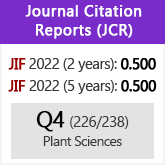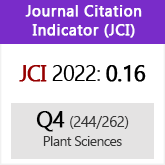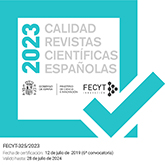Diatom species composition and indices for determining the ecological status of coastal Mediterranean Spanish lakes
DOI:
https://doi.org/10.3989/ajbm.2373Keywords:
Bacillariophyceae, bioindicadores, epifiton, lagunas interdunares, calidad del agua, DMAAbstract
Diatom indices have been used and tested mainly for assessing the ecological status of rivers and deep lakes, but there are scarce studies that determine their effectiveness in shallow lakes and in coastal Mediterranean lakes. This study evaluates the validity of several common diatom indices (SPI, BDI, CEC and TDIL) for the determination of the ecological quality of three coastal lakes (Valencia, Spain) and presents descriptions and ecological data of the main diatom species recorded. Diatom samples were collected from phytobenthos, both from epiphyton of the dominant submerged macrophytes and the sediment. The ecological status of the systems was determined according to different physico-chemical variables and was compared with the results obtained from epiphytic diatom communities. The results showed discrepancies among diatom indices and also with the state determined by the environmental variables. The effectiveness of the indices depended on the number of species assessed for each index with respect to the total species recorded and the suitability of the weight assigned to each species. The results reveal the need to gather more information about the composition and ecology of the diatoms and microalgae characteristic of coastal Mediterranean standing waters. This work contributes to their better knowledge.
Downloads
References
Aboal, M. 1989. Aportaciones al conocimiento de las algas del SE de Espa-a. IV. Las Diatomeas (Bacillariophyceae). Acta Botánica Malacitana 14: 13-40.
Álvarez-Blanco, I., Cejudo-Figueiras, C., Bécares, E. & Blanco, S. 2011. Spatiotemporal changes in diatom ecological profiles: implications for biomonitoring. Limnology, 12: 157-168. http://dx.doi.org/10.1007/s10201-010-0333-1
Álvarez-Blanco, I., Blanco, S., Cristina Cejudo-Figueiras, C. & Bécares, E. 2012. The Duero Diatom Index (DDI) for river water quality assessment in NW Spain: design and validation. Environmental Monitoring and Assessment. PMid:22461151
APHA. 1992. Standard Methods for the examination of water and wastewater. American Public Health Association. Washington D.C.
Blanco, S., Ector, L. & Bécares, E. 2004. Epiphytic diatoms as water quality indicators in Spanish shallow lakes. Vie Milieu- Life and Environment 54: 71-79.
Blanco, S., Ector, L., Huck, V., Monnier, O., Cauchie, H. M., Hoffmann L.& Bécares, E. 2008. Diatom assemblages and water quality assessment in the Duero Basin (NW Spain). Belgian Journal of Botany 141: 39-50.
BOE. 2008. Instrucción de Planificación Hidrológica. ORDEN ARM/2656/2008, de 10 de septiembre. Boletín Oficial del Estado 229: 38472- 38582.
Cantoral-Uriza, E.A. & Aboal, M. 2008. Diatomeas (Bacillariophyceae) del marjal Oliva-Pego (Comunidad Valenciana, Espa-a). Anales del Jardín Botánico de Madrid 65: 111-128. http://dx.doi.org/10.3989/ajbm.2008.v65.i1.249
CEDEX. 2010a. Establecimiento de condiciones hidromorfológicas y físicoquímicas específicas de cada tipo ecológico en masas de agua de la categoría lagos en aplicación de la Directiva Marco del Agua v 1.0 (Informe técnico). Centro de Estudios y Experimentación de Obras Públicas. Madrid. 70 pp.
CEDEX. 2010b. Establecimiento de condiciones de referencia y valores frontera entre clases de estado ecológico en masas de agua de la categoría lago para los elementos de calidad "composición, abundancia y biomasa de fitoplancton" y "composición, y abundancia de otro tipo de flora acuática, en aplicación de la directiva marco del agua (Informe técnico). Centro de Estudios y Experimentación de Obras Públicas. Madrid. 62 pp.
Cejudo-Figueiras, C. 2011. Monitorización de los ecosistemas dulceacuícolas mediante métricas basadas en diatomeas. Tesis doctoral. Universidad de León. 108 pp.
Cejudo-Figueiras, C., Blanco, S., Álavarez-Blanco, I., Ector, L. & Bécares, E. 2010. Nutrient monitoring in Spanish wetlands using epiphytic diatoms. Vie & Milieu - Life and Environment 60(2): 89-94.
CEMAGREF. 1982. Étude des méthodes biologiques d'appréciation quantitative de la qualité des eaux. Rapport Q.E. Lyon-A.F. Bassin Rhône-Méditeranée-Corse. 218 pp.
Confederación Hidrográfica del Duero. 2010. Guía de diatomeas de la cuenca del Duero. Ministerio de Medio Ambiente. 207 pp.
Della Bella, V. & Manzini, L. 2009. Freshwater diatom and macroinvertebrate diversity of coastal permanent ponds along a gradient of human impact in a Mediterranean eco-region. Hydrobiologia 634: 25-41. http://dx.doi.org/10.1007/s10750-009-9890-x
Descy, J.P. & Coste, M. 1990. Utilisation des diatomées benthiques pour l'évaluation de la qualité des eaux courantes. (Rapport final). Contrat CEE B-71-23 UNECED-NAMUR, CEMAGREF. Bordeaux.
DOCE. 2008. Commission Decision of 30 Octuber 2008, establishing, pursuat to Directive 2000/60/EC of the European Parliament and the Council, the values of the Member State monitoring system classifications as a result of the intercalibration exercise. DOCE nº L 332: 20-44, de 10 de diciembre de 2008. Bruselas.
European Parliament & The Council of the European Union. 2000. Directive 2000/60/EC of the European Parliamrnt and of the Council establishing a framework for the Community action in the field of water policy. Official Journal of the European Communities, L327: 1-72.
Germain, H. 1981. Flore des diatomées, eaux douces & saumatres. Société nouvelle des editions Boubée. Paris. 444 pp.
Kitner, M. & Poulícková, A. 2003. Littoral diatoms as indicators for the eutrophication of shallow lakes. Hydrobiologia 506-509: 519-524. http://dx.doi.org/10.1023/B:HYDR.0000008567.99066.92
Krammer, K. & Lange-Bertalot, H. 1991a. Bacillariophyceae: Centrales, Fragilariaceae, Eunotiaceae. In: &tl, H., Gerloff, J., Heynig, H. & Mollenhauer, D. (eds.), Süsswasserflora von Mitteleuropa. Band 2, 3 Teil. Gustav Fischer Verlag. Stuttgart-Jena. 576 pp.
Krammer, K. & Lange-Bertalot H. 1991b. Bacillariophyceae: Achnanthaceae, Kritische Ergänzungen zu Navicula (Lineolatae) und Gomphonema Gesamtliteraturverzeichnis. Teil 1-4. In: &tl, H., Gärtner, G., Gerloff, J., Heynig, H. & Mollenhauer, D. (eds.), Süsswasserflora von Mitteleuropa. Band 2, 4 Teil. Gustav Fischer Verlag. Stuttgart, Jena. 436 pp.
Krammer, K. & Lange-Bertalot, H. 1997a. Bacillariophyceae: Naviculaceae. In: &tl, H., Gerloff, J., Heynig, H. & Mollenhauer, D. (eds.), Süsswasserflora von Mitteleuropa. Band 2, 1 Teil. Gustav Fischer. Jena-Sttutgart-Lübeck-Ulm. 876 pp.
Krammer, K. & Lange-Bertalot, H. 1997b. Bacillariophyceae: Bacillariaceae, Epithemiaceae, Surirellaceae. In: &tl, H., Gerloff, J., Heynig, H. & Mollenhauer, D. (eds.), Su.sswasserflora von Mitteleuropa. Band 2, 2 Teil. Gustav Fischer. Jena-Sttutgart-Lübeck-Ulm. 610 pp.
Krammer, K. & Lange-Bertalot, H. 2000. Bacillariophyceae: English and French translation of the keys. In: Bu.del, B., Gärtner, G., Krienitz, L. & Lokhorst, G. M. (eds.), Süsswasserflora von Mitteleuropa. Vol. 2, part 5. Engl. transl.: N. Bate & A. Podzorksi. French transl.: J. Bukowska, M. Michel & J. Prygiel. Spektrum Akademischer Verlag GmbH. Heidelberg-Berlin. 310 pp.
Lange-Bertalot, H. 2001. Navicula sensu estricto. 10 genera separated from Navicula sensu lato. Frustulia. Diatoms of Europe. In: lange-Bertalot, H. (eds.), Diatoms of the Europe Inland waters and comparable habitats. Vol. 2. A.R.G. Ganter Verlag K.G. 526 pp.
Lecointe, C., Coste, M., Prygiel. J. 1993. OMNIDIA software for taxonomy, calculation of diatom indices and inventories management. Hydrobiologia 269/270: 509-513. http://dx.doi.org/10.1007/BF00028048
Lenoir, A. & Coste, M. 1996. Development of a practical diatom index of overall water quality applicable to the French national water Board network. In: Use of Algae for monitoring rivers II. Studia Student G.m.b.H. (ed.): 29-43. Innsbruck.
Moss, B., Stephen, D., Álvarez, C., Bécares, E., Van De Bund, W., Collings, S.E., Van Donk, E., De Eyto, E., Feldmann, T., Fernández-Aláez, C., Fernández-Aláez, M., Franken, R.J.M., García-Criado, F., Gross, E., Gyllström, M., Hansson, L.A., Irvine, K., Järvalt, A., Jensen, J.P., Jeppesen, E., Kairesalo, T., Kornijow, R., Krause, T., Künnap, H., Laas, A., Lill, E., Lorens, B., Luup, H., Miracle, M.R., Nõges, P., Nõges, T., Nykänen, M., Ott, L., Peczula, W., Peeters, E.T.H.M., Phillips, G., Romo, S., Russell, V., Salujõe, J., Scheffer, M., Siewertsen, K., Smal, H., Tesch, C., Timm, H., Tuvikene, L., Tonno, I., Virro, T., Vicente, E. & Wilson D. 2003. The determination of ecological status in shallow lakes − a tested system (ECOFRAME) for implementation of the European Water Framework Directive. Aquatic Conservation: Marine and Freshwater Ecosystems 13: 507-549. http://dx.doi.org/10.1002/aqc.592
Moss, B., Stephen, D., Balayla, D., Bécares, E., Collings, S.E., Fernández-Aláez, C., Fernández-Aláez, M., Ferriol, C., García, P., Gomá, J., Gyllström, M., Hansson, L.-A., Hietala, J., Kairesalo, T., Miracle, M.R., Romo, S., Rueda, J., Russell, V., Ståhl-Delbanco, A., Svensson, M., Vakkilainen, K., Valentín, M., Van De Bund, W. J., Van Donk, E., Vicente E. & Villena, M.J. 2004. Continental-scale patterns of nutrient and fish effects on shallow lakes: synthesis of a pan-European mesocosm experiment. Freshwater Biology 49: 1633-1649. http://dx.doi.org/10.1111/j.1365-2427.2004.01304.x
Prygiel, J. & Coste, M. 2000. Guide methodologique pour la mise en oeuvre de I'lndice Biologique Diatomees NF T 90-354. Agence de I'Eau Artois-Picardie-Cemagref, Bordeaux. 134 pp.
Romo, S., Villena, M.J., Sahuquillo, M., Soria, J.M., Giménez, M., Alfonso, T., Vicente, E. & Miracle, M.R. 2005. Response of a shallow Mediterranean lake to nutrient diversion: does it follow similar patterns as in northern shallow lakes? Freshwater Biology 50: 1706-1717. http://dx.doi.org/10.1111/j.1365-2427.2005.01432.x
Rovira, L., Trobajo R. & Ibá-ez, C. 2009. Periphytic diatom community in a Mediterranean salt wedge estuary: the Ebro Estuary (NE Iberian Peninsula). Acta Botanica Croatica 68 (2): 285-300.
Stenger-Kovács, C., Buezkó, K., Hajnal, E. & Padisák, J. 2007. Epiphytic, litoral diatoms as bioindicators of shallow lake trophic status: Trophic Diatom Index for Lakes (TDIL) developed in Hungary. Hydrobiologia 589: 141-154. http://dx.doi.org/10.1007/s10750-007-0729-z
Tomàs, X. 1982. El género Mastogloia en los sistemas acuáticos del litoral mediterráneo espa-ol. Collectanea Botanica 13(2): 929-944.
Trobajo, R. 2005. Ecological analysis of periphytic diatoms in Mediterranean coastal wetlands (Empordà wetlands, NE Spain). Tesis doctoral. Universitat de Girona. 171 pp.
UNE-EN 13946. 2004. Calidad del agua. Guía para el muestreo en rutina y el pretratamiento de diatomeas bentónicas de ríos.
Zimba, P.V. & Hopson, M.S. 1997. Quantification of epiphyte removal efficiency from submerged aquatic plants. Aquatic Botany 58: 173-179. http://dx.doi.org/10.1016/S0304-3770(97)00002-8
Downloads
Published
How to Cite
Issue
Section
License
Copyright (c) 2013 Consejo Superior de Investigaciones Científicas (CSIC)

This work is licensed under a Creative Commons Attribution 4.0 International License.
© CSIC. Manuscripts published in both the printed and online versions of this Journal are the property of Consejo Superior de Investigaciones Científicas, and quoting this source is a requirement for any partial or full reproduction.All contents of this electronic edition, except where otherwise noted, are distributed under a “Creative Commons Attribution 4.0 International” (CC BY 4.0) License. You may read here the basic information and the legal text of the license. The indication of the CC BY 4.0 License must be expressly stated in this way when necessary.
Self-archiving in repositories, personal webpages or similar, of any version other than the published by the Editor, is not allowed.

















